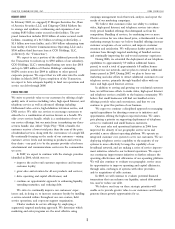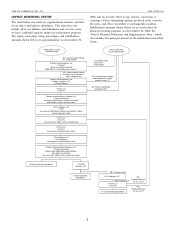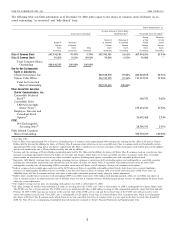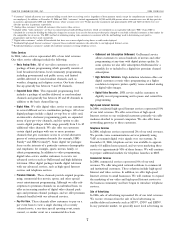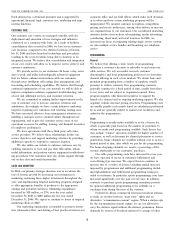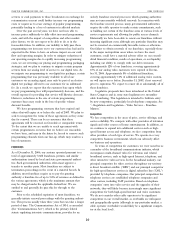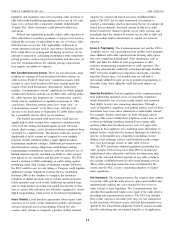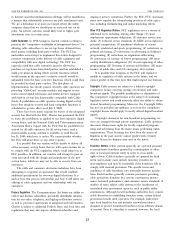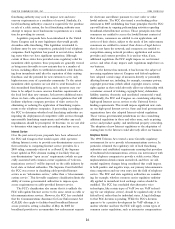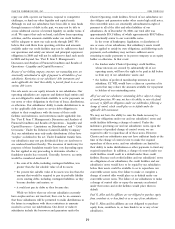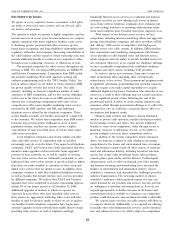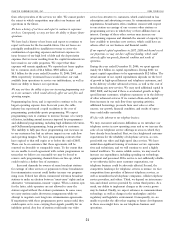Charter 2006 Annual Report Download - page 26
Download and view the complete annual report
Please find page 26 of the 2006 Charter annual report below. You can navigate through the pages in the report by either clicking on the pages listed below, or by using the keyword search tool below to find specific information within the annual report.
CHARTER COMMUNICATIONS, INC. 2006 FORM 10-K
others, they are attempting through various means (including financial and personnel resources, strong brand name recogni-
federal and state legislation and through FCC rulemaking) to tion, and long-standing relationships with regulatory authorities
weaken or streamline the franchising requirements applicable to and customers. Moreover, mergers, joint ventures and alliances
them. If telephone companies are successful in avoiding or among franchise, wireless, or private cable operators, local
weakening the franchise and other regulatory requirements that exchange carriers, and others, may result in providers capable of
are applicable to cable operators like Charter, their competitive offering cable television, Internet, and telephone services in
posture would be enhanced. We cannot predict the likelihood of direct competition with us. For example, major local exchange
success of the broadband services offered by our competitors or carriers have entered into arrangements with EchoStar and
the impact on us of such competitive ventures. The large scale DirecTV in which they will market packages combining
entry of major telephone companies as direct competitors in the telephone service, DSL, and DBS services.
video marketplace could adversely affect the profitability and Additionally, we are subject to competition from utilities
valuation of established cable systems. which possess fiber optic transmission lines capable of transmit-
DSL service allows Internet access to subscribers at data ting signals with minimal signal distortion. Utilities are also
transmission speeds greater than those available over conven- developing broadband over power line technology, which may
tional telephone lines. DSL service therefore is more competitive allow the provision of Internet and other broadband services to
with high-speed Internet access over cable systems than homes and offices. Utilities have deployed broadband over
conventional dial-up. Most telephone companies which already power line technology in a few limited markets.
have plant, an existing customer base, and other operational Broadcast Television
functions in place (such as, billing, service personnel, etc.), offer Cable television has long competed with broadcast television,
DSL service. DSL actively markets its service, and many which consists of television signals that the viewer is able to
providers have offered promotional pricing with a one-year receive without charge using an ‘‘off-air’’ antenna. The extent of
service agreement. The FCC has determined that DSL service is such competition is dependent upon the quality and quantity of
an ‘‘information service,’’ and based on that classification has broadcast signals available through ‘‘off-air’’ reception, compared
removed DSL service from many traditional telecommunications to the services provided by the local cable system. Traditionally,
regulations. Legislative action and the FCC’s decisions and cable television has provided higher picture quality and more
policies in this area are subject to change. We expect DSL to channel offerings than broadcast television. However, the recent
remain a significant competitor to our high-speed Internet licensing of digital spectrum by the FCC will provide traditional
services, particularly as we enter the telephone business and broadcasters with the ability to deliver high definition television
telephone companies aggressively bundle DSL with telephone pictures and multiple digital-quality program streams, as well as
service to discourage their customers from switching to cable advanced digital services such as subscription video and data
company services. In addition, the continuing deployment of transmission.
fiber into telephone companies’ networks will enable them to
provide higher bandwidth Internet service than provided over Traditional Overbuilds
traditional DSL lines. Cable systems are operated under non-exclusive franchises
We believe that pricing for residential and commercial granted by local authorities. More than one cable system may
Internet services on our system is generally comparable to that legally be built in the same area. It is possible that a franchising
for similar DSL services and that some residential customers authority might grant a second franchise to another cable
prefer our ability to bundle Internet services with video and/or operator and that such a franchise might contain terms and
telephone services, and prefer the higher Internet speeds we conditions more favorable than those afforded us. In addition,
have made more generally available. However, DSL providers entities willing to establish an open video system, under which
may currently be in a better position to offer data services to they offer unaffiliated programmers non-discriminatory access to
businesses since their networks tend to be more complete in a portion of the system’s cable system, may be able to avoid
commercial areas. They also have the ability to bundle local franchising requirements. Well-financed businesses from
telephone with Internet services for a higher percentage of their outside the cable industry, such as public utilities that already
customers, and that ability is appealing to many consumers. possess fiber optic and other transmission lines in the areas they
Joint marketing arrangements between DSL providers and DBS serve, may over time become competitors. There are a number
providers may allow some additional bundling of services. of cities that have constructed their own cable systems, in a
Charter offers telephone service in a majority of its service manner similar to city-provided utility services. There also has
areas. Charter also provides traditional circuit-switched tele- been interest in traditional cable overbuilds by private compa-
phone service in a few communities. In these areas, Charter nies. Constructing a competing cable system is a capital
competes directly with established telephone companies and intensive process which involves a high degree of risk. We
other carriers, including VoIP providers, for voice service believe that in order to be successful, a competitor’s overbuild
customers. Because we offer voice services, we are subject to would need to be able to serve the homes and businesses in the
considerable competition from telephone companies and other overbuilt area with equal or better service quality, on a more
telecommunications providers. The telecommunications industry cost-effective basis than we can. Any such overbuild operation
is highly competitive and includes competitors with greater would require either significant access to capital or access to
12


